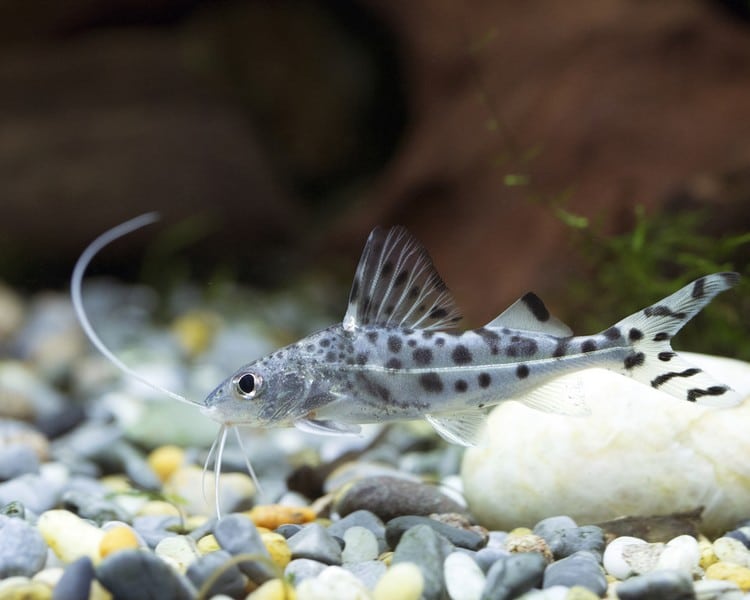Pictus catfish
Pictus catfish are popularly found in South American warm rivers. They are characterized by a silver-colored body with black spots spread all over. They possess barbels which are useful when searching for food and navigating certain terrains.


FISH SIZE
5 inches

TANK SIZE
44 gallons

LIFE SPAN
8 years

pH LEVEL
6-7.5

CARE
Medium

DIET
Omnivorous
Pictus Catfish are a schooling fish, and a tank with a carrying capacity of about 550 litres should be perfect for housing a group of 4. Their tank should be dimly lit, and a sound filtration system should be incorporated.
Watching the pictus catfish swim with grace in the aquarium will present any aquarium enthusiast with a beautiful sight to behold. On the flip side, however, they are not very easy to care for, but they remain an interesting choice of aquatic pet to have around.
Discover more about the uniqueness, feeding habit and compatibility of this freshwater wonder in this article. Also, learn about how you can take care of them without much difficulty…we also shed some light on their breeding pattern.
Introduction
Are you a vivarium hobbyist and looking for some hugely popular fish for your collection? You might be an amateur hobbyist or even a pro, but looking towards filling your community fish tank with some good mates like Pictus Catfish to attract your neighbor’s attention. Well, if that is the case, you have bumped into the right space as today we are going to discuss about Pictus Catfish in detail in this article.
About Pictus Catfish

Scientifically known as Pimelodus Pictus, Pictus Catfish is popularly known as Pictus cat and Angel cat and originates from the warm waters of Latin America. Having a white body highlighted with huge barbells and black spots, they are quite active and large fish in the aquarium. They require an easy-care level and have a peaceful temperament.
Pictus catfish size reaches up to the 5 inches in a well-kept aquarium and can live up to 8 years.
They belong to the family Pimelodidae and thrive in aquariums with a minimum of 55 gallons of water. Preferably, the fish tank needs to be set up in freshwater with driftwood and caves. The water of the aquarium should have a PH of 5.8-6.8 and a temperature of 22-25 degree Celsius. Since they are omnivorous in nature, pictus feed on pellets, flakes and frozen foods.
They can survive solo but prefer a shoal for better livelihood. The pectoral fins are quite sharp, so you must take care while transporting them. Instead of using a regular fishnet, use a plastic container to avoid any significant damage.
Catfish Diversity in General
There are almost 2900 varieties of catfish. Only 40 of them are from the United States. The most prominent species that can be exported is the Channel Catfish. They belong to the species-rich vertebrate and are of the order Siluriformes. Well, they vary in terms of size. While some remain smaller, the others may reach up to15 feet in dimension. The smaller varieties are known as Banjo (Aspredinidae) and grow up to an inch when fully matured.
Where from did Pictus Catfish originate?
Franz Steindachner, the Austrian zoologist, named this fish in 1876, as it found in the warm river beds of Latin America. You will find it all over in the Amazon and the Orinoco rivers which flow through Peru and Columbia.
There is another type of catfish that dwells in Africa called upside down catfish, a different species known as Synodontis. The fish generally inhabits in lentic waters, where the flow remains slow, and the bottom is covered in mud or sand. Generally, it is considered a schooling fish, and you can see them swimming in larger shoals.
Pictus Catfish is benthopelagic in nature and requires clean freshwater to thrive. They dwell in the bottom strata and start getting active while it’s dark. The fish finds smaller fishes, snails, and prawns as its prey and use their barbells for catching their prey.
How does a Pictus Catfish look like?
They have a silver body color with a lot of black spots on it. They possess transparent fins along with white barbells. The fish has a slender body and while in captivity they grow up to 5 inches in length. They are distinguished as they have whiskers which are often known as barbells. Sometimes these barbells even reach up to the caudal fins. While in the wild, the Pictus uses their barbells to navigate through muddy waters. They possess sharp spines and fins which are known to cause damage to other fishes.
Pictus Catfish has a forked tail and a large mouth which is a bit downturned and usually found to have an elongated body with a dorsal triangle. They use the barbells for finding food inside the muddy water.
The male and female fishes can be easily distinguished, as the females grow to be slightly rounder and larger once they reach maturity.
What is the life-span of a Pictus Catfish?
Generally, a catfish can live till 8 years if taken good care of. Else, others have a life span of 4-8 years.
How does the Pictus Catfish behave?
These fishes are known as active swimmers. Like other catfish, they are nocturnal in habit and bottom feeders. While kept in captive condition, they prefer soft water to thrive. They depend upon vegetables and other plants as well as other smaller fishes. These fishes are known to feed upon tetras.
Pictus Catfish are non-aggressive by nature and never harm fishes which are too large for them to be eaten.
Pictus require larger tanks as they are quite agile and swim fast. They are non-territorial by nature, and their sting can be mildly venomous though they are generally harmless towards humans.
What does the Pictus Catfish feed upon?
As told earlier that the Pictus Catfish is omnivorous in nature, they will feed anything starting from plant platter or might be smaller fishes. In fact, they scavenge anything that comes on their way. If you look at the waters of South America, then you will probably find them feeding upon snails, small fish, algae and insects (mostly dragonfly larvae).
Now, as you know that the Pictus Catfish prefers the bottom strata for catching their prey. They lay in hidden areas especially at the bottom of the tank. You must give them sinking pellets for their feed. The variety of fishes that could be given to them is:
- Brine shrimp and beef heart (as fresh food)
- Bloodworms and black worms (as frozen food)
- Vegetable pellet
You will see them foraging at the bottom of the aquarium looking for food. Catfishes have a large appetite. In case they are not full, they become omnivorous in nature and start chasing smaller fishes in the aquarium. Serving them with high-quality sinking pellets is the main motto of feeding the Pictus Catfish.
Note that they produce large amounts of excretion; hence cleaning up the aquarium at least twice a week becomes mandatory.
What are the various facts regarding feeding catfish that one needs to know?
Catfish has long barbells that they use while sourcing food in the deep. Well, they exhibit diversity in the feeding behavior. Some are true herbivores while others feed on flesh and become gigantic in dimension.
Different diet types for the Pictus Catfish
The catfish depends on their barbells to find food and also smells things. They are omnivorous in nature and see to consume smaller fish, other aquatic animals, invertebrates and fish eggs. Catfish belonging to the species Loricariidae feed on strange objects like algae and wood. Some giant catfish are seen consuming rodents, frogs and even aquatic birds. European Wels falls in this category that eats typical species.
The Process of Tracking Prey
There are various theories regarding the process of catching prey of Pictus Catfish. A study done on catfish in 2001 by Kirsten Pohlman says that it’s not only the sense of taste, smell and feel that help them to detect the prey but also the inability to avoid predator strategy in some preys allows the catfish to eat them. When such fish remain calm while their predator approaches, catfish take the advantage and eat their prey.
Type of Diet of Pictus Catfish changes with Age
The young channel catfish (Ictalurus punctatus) feed on aquatic insects like water beetles, fly larvae and dragonfly larvae. When they become adults, they consume seeds, small fish, crawfish, algae, and snails. Well, the channel fish sometimes may exceed 18 inches in length. Smaller fishes serve as the main component of their diet. Blue catfish which follows ontogenic dietary food habit are generally 10-15 inches in length, and they prefer fish diet over invertebrate based diet.
How do I set up the tank for Pictus Catfish?
Since we all know that Pictus Catfish is an active fish, the tank requires a larger space, a larger swimming area with at least 45 gallons (205 liters) of water. The species is non-territorial in nature and can exist peacefully in a handful area where the water is limited.
The tank containing Pictus Catfish should be dimly lit or might be having heavy aquatic plants at the bottom. Anyways, the fish stays away from other species by hiding beside the plants for the rest of the day. While they are kept in the relatively dimly lit aquarium, they will be active. You can make smaller caves inside the fish tank so that they can turn around and swim.
You may also try keeping the fish in a riverine biotope aquarium with plants, driftwoods, and river rocks which will stimulate a river in the tank. Try using clay pots inside the aquarium to make sufficient space for the Pictus. Adding java moss, hornwort and moss balls or any low light plants will also help make the fish tank look full and vibrant.
Choose a filter in the tank which is best to provide a strong flow of current of water. It's always better to choose a hang on the back filter since it allows for excellent filtration and a decent flow to your tank. You may even opt to hang a sponge filter which can allow maximum filtration inside the tank.
Make sure that the filter you use solves the purpose of cleaning the fish tank. Always choose a good filter that serves the purpose of keeping the fish tank sparkling clean thus making it perfect for the Pictus Catfish to dwell.
How do I make the Pictus Catfish breed?
Determining the sex of Pictus Catfish is also not a daunting task. The females become a bit roundish when it’s time to mate.
When the fish is kept in captivity, it happens to be the right time for breeding. You may stock a number of Pictus Catfish in an aquarium and then allow them to breed and keep doing that repeatedly to increase the chances of successful breeding.
For someone who is unable to recognize which is the male and which one is female, after trial and error, it’s possible to lock a single male and some female in the aquarium or vice versa. There tend to be high chances of breeding in this case.
Pictus Catfish care in the fish tank?
The Pictus Catfish is an active fish, and it requires a lot of space to swim in a tank. The minimum surface area needed for swimming is 200 liters (44 gallons). The fish is not a territory dependent kind, so you can easily keep them along with other fishes in a tank. You can also easily mix these fishes with at least 5 of its kind.
For the tank to be suitable for Pictus Catfish breeding, the hardness of the water has to remain around 6-15 degrees, the PH to vary from 6-7.5, and the temperature of the water should be 22-26 degree Celsius.
To keep the fish in the aquarium comfortably, you must make a lot of shelters and nookeries. To do that, you may create a biotype that resembles a river. Keep it with stones, snags, and sand. You may even try bringing some undemanding type of plants to decorate the tank like java moss and Anubias Nana.
Make sure that the lighting inside the aquarium should be of a dim-type and not very bright. The fish might try to hide during the day, and if the light is bright, it will have a tendency to hide always. Use a medium type water filter, so that it creates a medium type water flow which is ideal for the fish.
Since these fishes are very sensitive to nitrates and ammonia, so it becomes absolutely essential to clean the tank almost regularly.
While transporting the fish, you should be extra careful as they can sue the spines to sting. Although the sting is not venomous, the pain may exist for several hours. So it's always better to use a plastic container for transporting the fishes.
What are the common diseases of Pictus Catfish?
Since catfish is usually devoid of any scales, it’s susceptible to any surface disease such as white spot and itch. If you don’t maintain the water conditions appropriately, that may give rise to other diseases as well.
Generally, it’s seen that when the Pictus Catfish is affected by any disease, it tends to go downhill. This can often lead to the death of the fish. Thus, handling catfish can be challenging to the first time hobbyists.
Now, in case the catfish gets affected with an itch, the following symptoms occur:
- Catfish suffers from loss of appetite.
- It executes labored breathing.
- The fish will rub or scratch against fixed objects in the tank.
- The fish will tend to swim near the surface.
- Catfish will try to rest at the bottom.
- It will show signs like flashing.
- The fish will abstain from a shoal.
The various ways to avoid disease conditions in the tank are:
- Keep healthy fish only.
- Maintain proper aquarium conditions and keep it clean regularly.
- Make sure the fish has enough space to swim.
- Buy fishes from a known and reliable source, preferably a wholesaler or retailer. Avoid buying fishes from an online source.
- You may keep the fish in a quarantine tank to see if it exhibits any sort of disease. If you find it healthy, then you might put in the community tank.
Who can be the most compatible Pictus catfish tankmates ?
Pictus Catfish is known to be the most less-aggressive and non-territorial fish. But you should keep some points in mind while planning the tankmates of this fish type.
- As these fishes are omnivorous by habit, they will easily swallow smaller fishes when they feel hungry. So it’s advisable not to keep any small fish in the same fish tank.
- Pictus Catfish is an active fish. So, you must not keep any slow moving fish in the tank. Fishes like cichlids which are slow-moving can be harmed by the barbells of this Catfish. Remember, slow-moving fishes could be either harmed or irritated by Pictus.
- There is a popular belief that catfish is a bottom dweller, but this concept is not true. If your tank is filled with other community fishes like guppies and neons, then you may avoid catfish.
- Make sure that while you maintain a community tank, Pictus should be the fish of smallest dimension. After all, they're predatory in nature.
- Pictus Catfish always gets along well with tankmates who are very active. So you need to put these with fishes like giant danios, opaline gourami, and other catfish like Doradidae, Loricariid, and striped Raphael catfish.
- The fish can adjust well with the same specimen but make sure that they remain with shoals of at least 6.
What are the challenges of keeping Pictus Catfish in your vivarium collection?
Pictus Catfish is a hardy fish and preferred by hobbyists as a good choice for a community tank. With that said, there are certain challenges involved though. They are:
- Pictus is predator type, so be extra careful while choosing the tankmates. They should be fast-moving and bigger in size than catfish else they will be swallowed by it at any point.
- These fish are known to excrete a lot, and so you must clean your tank regularly.
- They have a good appetite, so you should choose the fish food accordingly.
- Since they're fish without scales, they are prone to be affected with various kinds of diseases.
- You need to be very careful while transporting the fish as they have sharp barbells that can injure you. Best is to transport through plastic containers.
- You need to keep a bigger sized tank for keeping Pictus Catfish as they need bigger space to swim and play around.
